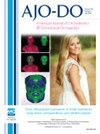Fibroblast growth factor 2 stimulates differentiation of mechanically-stressed human periodontal ligament fibroblasts into cementoblasts
IF 3
2区 医学
Q1 DENTISTRY, ORAL SURGERY & MEDICINE
American Journal of Orthodontics and Dentofacial Orthopedics
Pub Date : 2025-05-28
DOI:10.1016/j.ajodo.2025.04.023
引用次数: 0
Abstract
Introduction
Orthodontic treatment enables tooth movement through bone remodeling. The effects of fibroblast growth factor 2 (FGF2) on human periodontal ligament fibroblasts (HPdLFs) in response to mechanical stimulation that occurs during orthodontic treatment remain unexplained. We investigated the effects of FGF2 and mechanical stress on HPdLF differentiation, focusing on cementoblast differentiation.
Methods
The effects of FGF2 and mechanical stress (applied for 24 hours using a centrifuge) on HPdLFs were evaluated. Changes in marker levels were assessed using real-time reverse transcriptase-polymerase chain reaction and western blotting. Furthermore, the effect of FGF2 treatment on HPdLF mineralization was assessed after 3 and 5 weeks using Alizarin red S staining (BMK-R009: Bio Future Technologies, Tokyo, Japan).
Results
Treatment of HPdLFs with 20 ng/mL FGF2 increased the expression of CEMP1 and RUNX2 but did not significantly alter the expression of FGF2, FGFR1, and FGFR2. In HPdLFs exposed to mechanical stress, expression of FGFR1 and OCN was increased, whereas that of FGF2, CEMP1, CAP, GLUT1, ALP, and OPN was reduced considerably. Treatment of mechanically-stressed HPdLFs with FGF2 did not change FGF2 expression, but expression of FGFR1, CEMP1, CAP, and GLUT1 increased significantly. In addition, FGFR1 was significantly upregulated at the protein level, whereas cementoblast differentiation markers showed an upward trend. Mineralization showed no changes at 3 weeks. However, at 5 weeks, considerable mineralization was observed in mechanically-stressed cells continuously exposed to FGF2.
Conclusions
Mechanical stress increases FGFR1 expression in HPdLFs. FGF2 promotes the differentiation of mechanical-stressed HPdLFs into cementoblasts and their mineralization.
成纤维细胞生长因子2刺激机械应力下人牙周韧带成纤维细胞向成胶细胞分化。
正畸治疗通过骨重塑实现牙齿运动。在正畸治疗过程中,成纤维细胞生长因子2 (FGF2)对人牙周韧带成纤维细胞(HPdLFs)在机械刺激下的作用尚不清楚。我们研究了FGF2和机械应力对HPdLF分化的影响,重点是成水泥细胞分化。方法:观察FGF2和机械应力(离心作用24小时)对HPdLFs的影响。采用实时逆转录-聚合酶链反应和免疫印迹法评估标志物水平的变化。此外,FGF2处理对HPdLF矿化的影响在3周和5周后通过茜素红S染色进行评估(BMK-R009: Bio Future Technologies, Tokyo, Japan)。结果:用20 ng/mL FGF2处理HPdLFs可增加CEMP1和RUNX2的表达,但未显著改变FGF2、FGFR1和FGFR2的表达。在暴露于机械应力的HPdLFs中,FGFR1和OCN的表达增加,而FGF2、CEMP1、CAP、GLUT1、ALP和OPN的表达显著降低。用FGF2处理机械应力HPdLFs没有改变FGF2的表达,但FGFR1、CEMP1、CAP和GLUT1的表达显著增加。此外,FGFR1在蛋白水平上显著上调,而成水泥细胞分化标志物呈上升趋势。3周时矿化无变化。然而,在5周时,在连续暴露于FGF2的机械应激细胞中观察到相当大的矿化。结论:机械应力增加了HPdLFs中FGFR1的表达。FGF2促进机械应力HPdLFs向成水泥细胞分化及其矿化。
本文章由计算机程序翻译,如有差异,请以英文原文为准。
求助全文
约1分钟内获得全文
求助全文
来源期刊
CiteScore
4.80
自引率
13.30%
发文量
432
审稿时长
66 days
期刊介绍:
Published for more than 100 years, the American Journal of Orthodontics and Dentofacial Orthopedics remains the leading orthodontic resource. It is the official publication of the American Association of Orthodontists, its constituent societies, the American Board of Orthodontics, and the College of Diplomates of the American Board of Orthodontics. Each month its readers have access to original peer-reviewed articles that examine all phases of orthodontic treatment. Illustrated throughout, the publication includes tables, color photographs, and statistical data. Coverage includes successful diagnostic procedures, imaging techniques, bracket and archwire materials, extraction and impaction concerns, orthognathic surgery, TMJ disorders, removable appliances, and adult therapy.

 求助内容:
求助内容: 应助结果提醒方式:
应助结果提醒方式:


